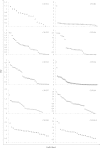Detection of genome-wide copy number variations in two chicken lines divergently selected for abdominal fat content
- PMID: 24962627
- PMCID: PMC4092215
- DOI: 10.1186/1471-2164-15-517
Detection of genome-wide copy number variations in two chicken lines divergently selected for abdominal fat content
Abstract
Background: The chicken (Gallus gallus) is an important model organism that bridges the evolutionary gap between mammals and other vertebrates. Copy number variations (CNVs) are a form of genomic structural variation widely distributed in the genome. CNV analysis has recently gained greater attention and momentum, as the identification of CNVs can contribute to a better understanding of traits important to both humans and other animals. To detect chicken CNVs, we genotyped 475 animals derived from two broiler chicken lines divergently selected for abdominal fat content using chicken 60 K SNP array, which is a high-throughput method widely used in chicken genomics studies.
Results: Using PennCNV algorithm, we detected 438 and 291 CNVs in the lean and fat lines, respectively, corresponding to 271 and 188 CNV regions (CNVRs), which were obtained by merging overlapping CNVs. Out of these CNVRs, 99% were confirmed also by the CNVPartition program. These CNVRs covered 40.26 and 30.60 Mb of the chicken genome in the lean and fat lines, respectively. Moreover, CNVRs included 176 loss, 68 gain and 27 both (i.e. loss and gain within the same region) events in the lean line, and 143 loss, 25 gain and 20 both events in the fat line. Ten CNVRs were chosen for the validation experiment using qPCR method, and all of them were confirmed in at least one qPCR assay. We found a total of 886 genes located within these CNVRs, and Gene Ontology (GO) and Kyoto Encyclopedia of Genes and Genomes (KEGG) pathway analyses showed they could play various roles in a number of biological processes. Integrating the results of CNVRs, known quantitative trait loci (QTL) and selective sweeps for abdominal fat content suggested that some genes (including SLC9A3, GNAL, SPOCK3, ANXA10, HELIOS, MYLK, CCDC14, SPAG9, SOX5, VSNL1, SMC6, GEN1, MSGN1 and ZPAX) may be important for abdominal fat deposition in the chicken.
Conclusions: Our study provided a genome-wide CNVR map of the chicken genome, thereby contributing to our understanding of genomic structural variations and their potential roles in abdominal fat content in the chicken.
Figures


Similar articles
-
Detection of breed-specific copy number variations in domestic chicken genome.Genome. 2018 Jan;61(1):7-14. doi: 10.1139/gen-2017-0016. Epub 2017 Sep 29. Genome. 2018. PMID: 28961404
-
Identification and functional characterization of copy number variations in diverse chicken breeds.BMC Genomics. 2014 Oct 25;15(1):934. doi: 10.1186/1471-2164-15-934. BMC Genomics. 2014. PMID: 25344733 Free PMC article.
-
Genome-wide copy number profiling using high-density SNP array in chickens.Anim Genet. 2015 Apr;46(2):148-57. doi: 10.1111/age.12267. Epub 2015 Feb 6. Anim Genet. 2015. PMID: 25662183
-
Genome wide copy number variations using Porcine 60K SNP Beadchip in Landlly pigs.Anim Biotechnol. 2023 Nov;34(6):1891-1899. doi: 10.1080/10495398.2022.2056047. Epub 2022 Apr 4. Anim Biotechnol. 2023. PMID: 35369845 Review.
-
Copy number variants and selective sweeps in natural populations of the house mouse (Mus musculus domesticus).Front Genet. 2014 Jun 3;5:153. doi: 10.3389/fgene.2014.00153. eCollection 2014. Front Genet. 2014. PMID: 24917877 Free PMC article. Review.
Cited by
-
Whole Genome Resequencing Revealed the Genetic Relationship and Selected Regions among Baicheng-You, Beijing-You, and European-Origin Broilers.Biology (Basel). 2023 Nov 3;12(11):1397. doi: 10.3390/biology12111397. Biology (Basel). 2023. PMID: 37997996 Free PMC article.
-
Characterization of Copy Number Variation's Potential Role in Marek's Disease.Int J Mol Sci. 2017 May 9;18(5):1020. doi: 10.3390/ijms18051020. Int J Mol Sci. 2017. PMID: 28486430 Free PMC article.
-
Genome wide detection of CNV and their association with body size in Danzhou chickens.Poult Sci. 2024 Dec;103(12):104266. doi: 10.1016/j.psj.2024.104266. Epub 2024 Aug 25. Poult Sci. 2024. PMID: 39293262 Free PMC article.
-
Identify Candidate Genes Associated with the Weight and Egg Quality Traits in Wenshui Green Shell-Laying Chickens by the Copy Number Variation-Based Genome-Wide Association Study.Vet Sci. 2024 Feb 6;11(2):76. doi: 10.3390/vetsci11020076. Vet Sci. 2024. PMID: 38393094 Free PMC article.
-
Genomic Insights Into the Multiple Factors Controlling Abdominal Fat Deposition in a Chicken Model.Front Genet. 2018 Jul 19;9:262. doi: 10.3389/fgene.2018.00262. eCollection 2018. Front Genet. 2018. PMID: 30073018 Free PMC article. Review.
References
-
- Nelson CL, Pelak K, Podgoreanu MV, Ahn SH, Scott WK, Allen AS, Cowell LG, Rude TH, Zhang Y, Tong A, Ruffin F, Sharma-Kuinkel BK, Fowler VG., Jr A genome-wide association study of variants associated with acquisition of Staphylococcus aureus bacteremia in a healthcare setting. BMC Infect Dis. 2014;14(1):83. doi: 10.1186/1471-2334-14-83. - DOI - PMC - PubMed
-
- Redon R, Ishikawa S, Fitch KR, Feuk L, Perry GH, Andrews TD, Fiegler H, Shapero MH, Carson AR, Chen W, Cho EK, Dallaire S, Freeman JL, González JR, Gratacòs M, Huang J, Kalaitzopoulos D, Komura D, MacDonald JR, Marshall CR, Mei R, Montgomery L, Nishimura K, Okamura K, Shen F, Somerville MJ, Tchinda J, Valsesia A, Woodwark C, Yang F, et al. Global variation in copy number in the human genome. Nature. 2006;444(7118):444–454. doi: 10.1038/nature05329. - DOI - PMC - PubMed
Publication types
MeSH terms
Associated data
- Actions
LinkOut - more resources
Full Text Sources
Other Literature Sources
Molecular Biology Databases
Miscellaneous

